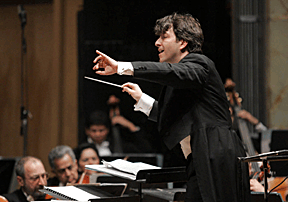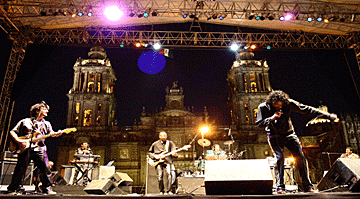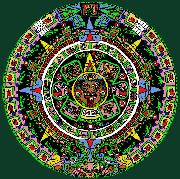MEXICO
CITY CELEBRATES CULTURE WITH FESTIVAL CENTRO HISTÓRICO
by Bob Brooke
 Vying
with Tokyo as the largest city in the world, Mexico City offers a myriad
of cultural opportunities. But none shows it off more than the annual
Festival Centro Histórico. In its 22nd year, the Festival,
running from March 25 to April 8, will offer some of the best in
international music, art, dance, and theatre to nearly 600,000
enthusiastic fans. Vying
with Tokyo as the largest city in the world, Mexico City offers a myriad
of cultural opportunities. But none shows it off more than the annual
Festival Centro Histórico. In its 22nd year, the Festival,
running from March 25 to April 8, will offer some of the best in
international music, art, dance, and theatre to nearly 600,000
enthusiastic fans.
Chick Corea and the flamenco band, Touchstone,
head up an all-star line-up of performers, together with Los
Aterciopelados (The Velours) from Columbia, who blend the rhythmic
sounds of soft rock and punk to create a sound all their own. Noche Ndam
gos pa, the encounter of the virtuosos of sung words and dance, brings
Latin American and African rhythms together in percussion pieces while
Victor Ullate dances a love story, with music composed by Enrique
Morente and his daughter Estrella, that shows how love influences life
using a mix of traditional dance and flamenco.
The Festival features not only opera, music,
and dance performances but visual arts exhibits from more than 1,800
artists from 20 countries in 250 programs performed in 90 venues
throughout the hsitoric district, including the Teátro de la Ciudad,
Belles Artes, Catédral Metroplitana, and the Palacio Postal. In
addition, experts will give lectures and famous writers will share their
work in seminars. Visiting performers will also give master classes and
workshops to encourage Mexican students to create their own works. In
addition, there will also be children's activities including
storytelling, museum tours, arts and crafts activities and games.
"Mexico City's Centro Histórico is known
as the most important in Latin America," said Jose Arean, the
Festival’s director for the last five years. "In this one
location, visitors can experience Mexico's history and culture going
back to the time of the Aztecs mixed with the vibrant arts of
today."
Beginnings
Beginning
in 1985 as a non-profit enterprise to help rescue the art of this
historic district, the Festival has, over the years, contributed to the
cultural awareness of the area by presenting national and international
artists of high quality in its beautiful patios, government buildings,
palaces, cloisters and churches, with the support of the Mexico City
Government and the National Council for Culture and the Arts.
"Because the Festival began as a
not-for-profit, that set it apart from the rest of the festivals in
Mexico," Arean said. "For us, one of the big challenges every
year is that we do not have an assigned budget from the government but,
instead, have to find our own means to create the program each
year."
"We have sponsors–Telmex, Banamex,
Modelo, and Pepsi–that have been with us for many years," he
added. "We can count on them because we’ve developed a long-term
relationship with them. We know we’re going to have a certain amount
of money to spend. On the other hand, we do have government
contributions, which, together make up about 35 percent of our budget.
The rest comes from ticket sales."
Arean stressed that the concept of privately
sponsored events was a radical idea in Mexico when the Festival first
started. Today, many festivals and artistic groups have sponsors. Unlike
many festivals in the United States where patrons have to pay for every
event, only about ten percent of the Festival Centro Histórico events
require a ticket. This, according to Arean, draws a much more diverse
audience, from older people who like classical music to younger ones who
like rock, and even families.
Effects of the
Festival
One of the major effects of the Festival has been the change in the use
of the Zócalo. "We got together with the Mexico City Government
about ten years ago to find better ways of using the Zócalo, the third
largest city square in the world," continued Arean. "Formerly,
it had only been used for demonstrations or civil parades. It was the
idea of the City Government, through the festival, to open up this huge
area to cultural events, which now attract hundreds of thousands of
people every year."
In addition, the Festival uses many smaller
plazas and buildings throughout the historic district, making more
people, especially Mexicans, aware of the fantastic cultural heritage
that is on their doorstep.
 El
Centro Historico, the Historic Center, began as the hub of the
Aztec Empire in its capital, Tenochtitlán and continues to be the
center of the Mexico City's cultural life. The focus of the Centro
Histórico is the Plaza de la Constitución or, as it’s
popularly known, El Zócalo. Covering nearly 670 blocks,
the Centro Historico houses over 400 important cultural sites and
monuments. After the Revolution of 1910, the area began to fall into
decay. By 1960, Mexico City’s once-proud center had fallen on hard
times. It was during this time that an interest arose to recover and
preserve the artistic and historic heritage of the area. El
Centro Historico, the Historic Center, began as the hub of the
Aztec Empire in its capital, Tenochtitlán and continues to be the
center of the Mexico City's cultural life. The focus of the Centro
Histórico is the Plaza de la Constitución or, as it’s
popularly known, El Zócalo. Covering nearly 670 blocks,
the Centro Historico houses over 400 important cultural sites and
monuments. After the Revolution of 1910, the area began to fall into
decay. By 1960, Mexico City’s once-proud center had fallen on hard
times. It was during this time that an interest arose to recover and
preserve the artistic and historic heritage of the area.
While the revitalization of the Centro
Histórico is a vital part of a city-wide program to preserve Mexico
City’s cultural and historic heritage, the Festival doesn’t raise
money for building conservation. Rather it restores oil paintings and
other works of art in its churches. "This year, we’re giving back
to the Cathedral two large paintings out of a series of four by Miguel
Cabrera," said Arean. "During the Festival, a ceremony will be
held in the Cathedral with a concert afterwards. Also, there will be a
photographic exhibition showing the process of restoration of the
paintings."
Unique
Characteristics
Another unique characteristic of this arts festival is that, unlike
others that feature the same artists from year to year, it showcases
different artists in the same categories each year. "We try never
to repeat artists," said Arean. "We’re always on the lookout
for the extraordinary, the creative, the original. We try to feature
artists that are either unknown, have never participated, or have a
unique project that we can premiere."
"This is a challenge for our
programming," admitted Arean, "but it adds a lot of
originality and creativity to the event." Arean noted that the
audiences in Mexico are so curious and so interested that they migrate
easily between different genres.
Another popular feature of the Festival are the
masters classes. In the past, Bobby McFarrin
not only conducted the Mexico City Philharmonic, but did solo work and a
master’s class. Winton Marsalis turned the Belles Artes into one big
classroom, demonstrating techniques with a Mexican band. "We like
to have Mexican groups contact each other and work with other artists
who come in for the Festival," added Arean. "Sometimes new
projects result."
Featured Artists
for 2006
This year, the Festival will also pay tribute to Wolfgang Amadeus Mozart’s
250th anniversary through a selection of little known and
seldom played works for chamber orchestras. A Mexican violinist will be
playing with one such group from the Czech Republic, the Skampa Quartet.
Another highlight of this year’s Festival
will be the performance of the opera "El Ocaso de Los Dioses,"
The Twilight of the Gods, one of Mexico’s most important contributions
to the genre.
Visual arts exhibits at this year’s Festival
will focus on the theme of "Creation." Artists will present
their interpretations of the theme in solo and collective exhibitions.
Photographer Bob Schalkwijk will show his photos depicting the customs
of Mexico’s ethnic groups.
Tickets for Festival events that require them
range from under $10 to under $130. For more information, visit the Festival
website.
|

